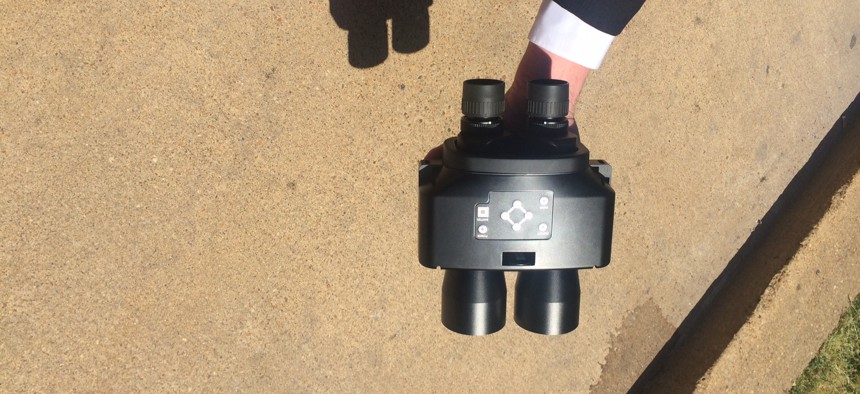
One of three prototypes of the Navy's face-recognition binoculars PATRICK TUCKER
The Navy’s New Binoculars Can Identify You From 700 Feet Away
Collecting on-the-ground intelligence may have become a bit safer.
It can be difficult to spot a face in the crowd, especially when the face belongs to someone who wants to kill you. That’s why the Navy is working to develop a wireless 3-D binocular face-recognition system.
At the Defense Department’s inaugural Lab Day, held in the Pentagon’s courtyard, Defense One got up close and personal with a working prototype that can ID someone at 225 meters, about two football fields away. The image recognition isn’t necessarily superior to what you could get from a high-resolution camera feed mounted on a surveillance drone. But spotting particular individuals from the air poses a unique challenge because you’re mostly looking at the tops of people’s heads. The binoculars promise much better face matching because they work at, well, face level.
“The image is captured, sent to our system, which does a few software enhancements, and it’s run against a local database,” said Michael Richmond, who manages the project at the Space And Naval Systems Warfare Center (Atlantic). “Most facial recognition systems are a few meters at most; nothing is this far at a handheld capability.”
In January 2013, the Navy awarded its first contract for a system to “increase the stand-off identification of uncooperative subjects,” according to a solicitation announcement. The winner was StereoVision, a California company that had already demonstrated a set of face-recognizing spectacles called the Wireless 3D Binocular Face Recognition System. This 3DMobileID could pick out a face and match it to a database at 100 to 200 meters. The prototypes on display at the Lab Day can reach about twice as far.
Currently, the system uses point-matching software from Cognitec, but Richmond said it was designed to be interoperable with any commercial face-recognition software.
Like any face-rec device, the binoculars are only as good as the database that the machine pulls images and potential matches from. For the military, that means the biometrically-enabled watch list, or BEWL. Always growing, the BEWL currently holds the facial records of some 200,000 people from around the world. In the past 10 years, many have come from the battlefields of Afghanistan and Iraq.
“We’re looking to incorporate a 50k watchlist from the BEWL onto another system for additional testing,” said Richardson. There’s no reason, at least theoretically, why future versions of the binoculars couldn’t pull from much larger databases. By year’s end, the FBI’s Next Generation Identification database is expected to hold as many as 52 million records.
Richmond said that the prototype systems cost $30,000 apiece, a price tag that could decrease if scale increases.
Face-recognition binoculars could play an important role in developing better intelligence in real time. That could help identify threats faster or reduce casualties from errant drone strikes. The most critical intelligence, related to friends and foes, will still be developed by men and women in the field. New face-ID tech will help put a bit more distance between them and the enemy.
NEXT STORY: China May Be Selling Armed Drones to Jordan




